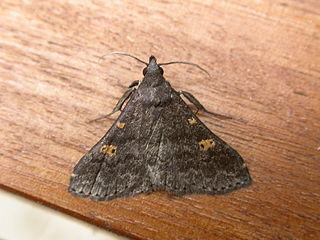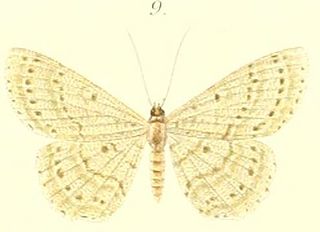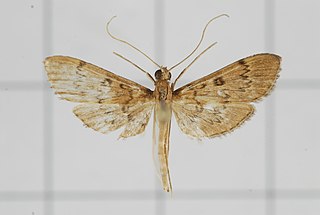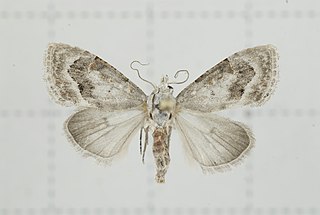Related Research Articles

Naarda is a genus of moths containing over 100 species. It was described by Francis Walker in 1866 and is in the family Erebidae.
Tatobotys is a genus of moths of the family Crambidae described by Arthur Gardiner Butler in 1881.

Arsacia is a monotypic moth genus of the family Noctuidae. Its only species is Arsacia rectalis. Both the genus and species were described by Francis Walker, the genus in 1866 and the species in 1863. It is found from the Indo-Australian tropics of India, Sri Lanka to Queensland and the Solomon Islands.
Curena caustopa is a species of snout moth in the genus Curena described by Alfred Jefferis Turner in 1905. It is found in Queensland, Australia.
Curena externalis is a species of snout moth in the genus Curena. It was described by Francis Walker in 1866. It is found in the Australian states of New South Wales and Queensland.

Hypena gonospilalis is a species of moth of the family Erebidae first described by Francis Walker in 1866. It is found across the South Pacific, including the Cook Islands, Japan and Taiwan as well as the Australian state of Queensland.

Catoria delectaria is a moth of the family Geometridae. It is found in Australia (Queensland).
Strepsicrates semicanella is a species of moth of the family Tortricidae first described by Francis Walker in 1866. It is found in south-east Asia and in New Caledonia, Australia and Japan. The habitat consists of alluvial forests.

Chalcidoptera emissalis is a moth in the family Crambidae. It was described by Francis Walker in 1866. It is found in north-eastern India, Sri Lanka, Burma, Singapore, Borneo, Ambon Island, Aru, New Guinea and Australia, where it has been recorded from Queensland.
Conogethes semifascialis is a moth in the family Crambidae. It was described by Francis Walker in 1866. It is found in India and Australia, where it has been recorded from New South Wales and Queensland.
Cydalima diaphanalis is a moth in the family Crambidae. It was described by Francis Walker in 1866. It is found in Burma, Indonesia, on the Solomon Islands and in Thailand and Australia, where it has been recorded from Queensland and South Australia.
Nausinoe globulipedalis is a moth in the family Crambidae. It was described by Francis Walker in 1866. It is found in Indonesia (Sulawesi), New Guinea and Australia, where it has been recorded from Queensland.
Nosophora hypsalis is a moth in the family Crambidae. It was described by Francis Walker in 1866. It is found in the Aru Islands of Indonesia and Australia, where it has been recorded from Queensland.
Omiodes surrectalis is a moth in the family Crambidae. Described by Francis Walker in 1866, it is found in the Democratic Republic of the Congo, India, Indonesia, the Philippines, Sri Lanka, New Guinea and Queensland, Australia.

Tatobotys janapalis is a moth in the family Crambidae. It was described by Francis Walker in 1859. It is found in Japan, Taiwan, Sri Lanka, India, Myanmar, Borneo, Indonesia the Solomon Islands. It is also found in Australia, where it has been recorded from Queensland and New South Wales.
Cryptophasa balteata is a moth in the family Xyloryctidae. It was described by Francis Walker in 1866. It is found in Australia, where it has been recorded from New South Wales, Queensland and South Australia.
Agriophara atratella is a moth in the family Depressariidae. It was described by Francis Walker in 1866. It is found in Australia, where it has been recorded from Queensland and New South Wales.
Pharambara micacealis is a moth of the family Thyrididae first described by Francis Walker in 1866. It is found in Sri Lanka, New Guinea and Australia.
Giaura tortricoides is a moth of the family Nolidae first described by Francis Walker in 1865. It is found in Sri Lanka, Japan, Andaman Islands, Borneo, Sumatra, Flores, Sulawesi, New Guinea, Bismarck Islands and Australia.

Nola fasciata is a moth of the family Nolidae first described by Francis Walker in 1866. It is found in Indo-Australian tropics of India, Sri Lanka to Borneo, Taiwan, New Guinea and Australia.
References
- ↑ Nuss, M.; et al. (2003–2014). "GlobIZ search". Global Information System on Pyraloidea. Retrieved 2014-07-15.
- ↑ Savela, Markku. "Tatobotys biannulalis (Walker, [1866])". Lepidoptera and Some Other Life Forms. Retrieved February 1, 2018.
- ↑ Lepidoptera Larvae of Australia
| This Steniini-related article is a stub. You can help Wikipedia by expanding it. |